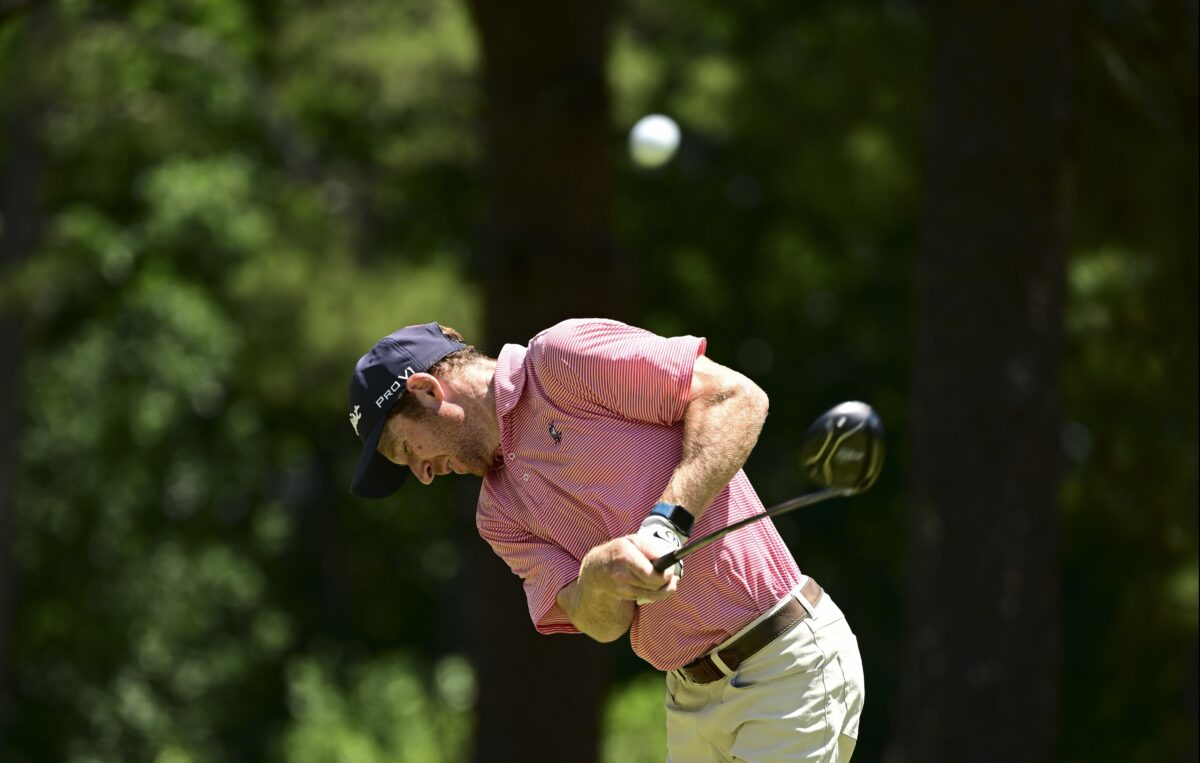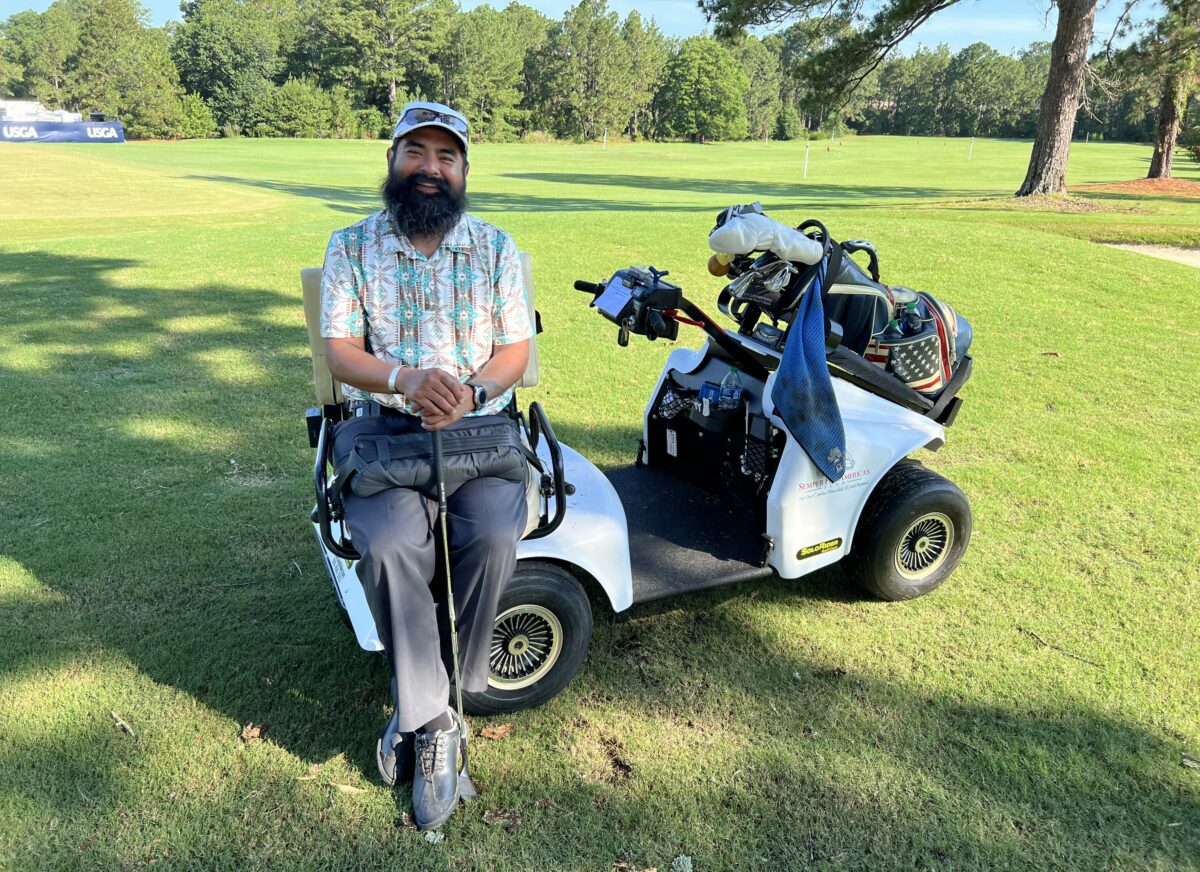Golf has been in a chaotic state of late. Many believe the very soul of the game is at stake. But not here at the U.S. Adaptive Open. Not at Pinehurst No. 6, where the only talk of money came when friends lined up at the bar to get a drink off Jeremy Bittner after he bagged the championship’s first ace.
Talk of tour golf centered around whether or not this giant leap in the adaptive game could lead to a circuit linked with the PGA Tour. Much like the DP World Tour has with the G4D (Golf for Disabled) Tour, a seven-event series that utilizes the same course during the same tournament week.
Brian Bemis almost missed his first-round tee time on No. 6 because he forgot his parking pass. The fact that the event required a parking pass was a testament to how official everything felt to these 96 players. Bemis, a man who plays golf with crutches because, after 57 surgeries and three amputations, he can no longer wear a prosthetic, took great pride in clipping on the same kind of player badge he’s seen U.S. Open contestants wear for decades.
“This is the greatest thing I have ever received from playing golf,” he beamed.
To witness Bemis hit a golf ball on one leg is nothing short of extraordinary. Jake Olson, a blind golfer who works as a strength and conditioning coach by trade, played alongside Bemis for two rounds.
“That dude, by swinging on one leg,” said Olson, “probably does more athletic movement and more incredible movement than I’d say any athlete bilaterally on any major sports team in the country.”
Here’s Brian Bemis in slow-mo. This man has had 57 surgeries. Absolutely loves the game. Plays off a 6.7 handicap. pic.twitter.com/kOQEMFTyMu
— Beth Ann Nichols (@GolfweekNichols) July 19, 2022
Respect runs deep at the Adaptive Open. Contestants and their families understand the amount of fortitude and strength it has taken to become part of this historic field. There are 24 players with handicaps that are better than scratch. Pros and amateurs, men and women, compete alongside each other. The oldest player is 80-year-old Judi Brush (leg impairment) and the youngest is 15-year-old Sophia Howard (arm impairment).
“This isn’t about money and contracts,” said USGA CEO Mike Whan, “this is about meaning.”
Ken Green won five times on the PGA Tour before losing his leg in an RV accident. In the final round, Green teed it up with Jordan Thomas, a 33-year-old who lost both legs in a boating accident at age 16. Thomas started a foundation that provides prosthetics to children while he was still in the hospital and plays off a handicap index of +1.6.
Players in this field talk about growing the game in ways that are life-changing. Even life-saving.
Randy Shack, an Army vet whose spinal cord was injured by five roadside bombs, was homebound for nearly a decade because he didn’t want to go out in public in a wheelchair.
Now he’s an ambassador for PGA HOPE, a program that seeks to engage veterans in the game. Shack, who competed in the seated category at Pinehurst, marveled that this is the first adaptive tournament he’s played in that had wheelchair-accessible bathrooms on the course.
Gratitude overflows here.
As with any first, there’s room for improvement. Finding a way to televise what happened here would be a fine place to start. A “Live From” show on Golf Channel that highlights not only what these players have overcome, but their jaw-dropping athleticism would go a long way toward showing what’s possible.
The world needs to see this.

Dennis Walters, the renowned trick-shot artist who is in the World Golf Hall of Fame, said at the start of the week that this must have been what it felt like to be Horace Rawlins in 1895, when the first U.S. Open was staged with 11 competitors. There were seven this week in Walters’ seated category.
“This is the first one,” he said. “That’s why I wanted to be here.”
But not without his dog, Gussie, short for Augusta. There were two service dogs in the field this week, the millionth reason why this event was better than any other this year.
Luke Carroll, 17, was one of four teenagers in Pinehurst. When he was 10, Carroll played AAU basketball and was the quarterback on his football team and the left-handed pitcher on his travel baseball team. One Saturday, Carroll complained about back pain after a basketball game. The next day, he was paralyzed from the waist down with idiopathic transverse myelitis, an inflammation of the spinal cord.
Carroll had to learn how to walk again and refused to live his life in a wheelchair. He fell in love with golf, and now carries a +0.3 handicap index and a dream of playing college golf at Vanderbilt.
“I’ve never played with anyone else like me,” said Carroll of his first adaptive tournament.

Bemis would like to see the USGA expand the Adaptive Open to include regional qualifiers for players who aren’t already exempt, like they do for other championships.
“That way it’s more of a truer Open, if you will,” he said.
This week was an important step toward adding golf to the Paralympic Games, a hot topic of conversation in this close-knit community.
The USGA’s 15th championship will no doubt inspire both the disabled and able-bodied to push through boundaries in the pursuit of excellence.
As one parent on the range said before the start of the final round, what a gift this week has been.
No one here will ever be the same.
[vertical-gallery id=778285152]
[mm-video type=playlist id=01es6rjnsp3c84zkm6 player_id=none image=https://golfweek.usatoday.com/wp-content/plugins/mm-video/images/playlist-icon.png]








